Don't wanna be here? Send us removal request.
Video
youtube
Curious about the longevity of this albums impact. Really interesting genre fusion, into it.
0 notes
Text
March 24/18: “Post Structuralist Vulva Colouring Book.”
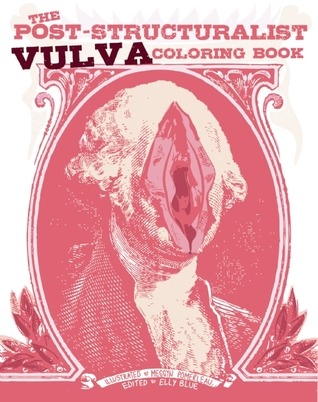
A couple weeks ago I was surfing the net to find contemporary artists who were influenced by post structuralism but even more specifically artists who were influenced by the writings of Craig Owens. I was not overly successful although I did come across this gem that I must share. It is a colouring book that is intended to “demystify gender and interrogates your assumptions as you are drawn into its mesmerizing patterns, folds, and whorls. Color away the false binaries between male and female, words and text, inside and outside, art and nature” (Microcosm p2.) It was illustrated by Meggyn Pomerleau and edited by Elly Blue. Best part about it is each page features a quote from a Post-Structuralist philosopher, I may have to pick it up for a buddy of mine.
0 notes
Text
March 16/18: What is Post-Modernism?
Question: What is Post-Modernism? Define the term and apply to the work of an artist from the “Pictures Generation?”
Post Modernism is a reaction to Modernism’s idea about the myth of the author and focuses on context over aesthetic within pieces. Early Post-Modern artists used unique mixed mediums and subjects like pastiche, appropriation, oppositional themes and parody. It was created under the banner of “Pluralism” and is heavily influenced by Post-Structuralism. It is the deconstruction of the concept of High vs Low art.
An artist part of the “Pictures” show in 1977 in New York City was Sherrie Levine. Sherrie Levine is a famous post-modernist artist, who’s work focuses on appropriating famous pieces from male artists. Appropriation art is a huge part of Post-Modernism and her challenging ideas enhance that spirit as well. In this work she appropriates a photograph my Edward Weston by rephotographing it and making miner dodging and burning. This is a representation of the that photograph but it is not the same photograph taken by Walker Evans. This cheeky concept of showing how representation can be many different things is very Post-Modern.
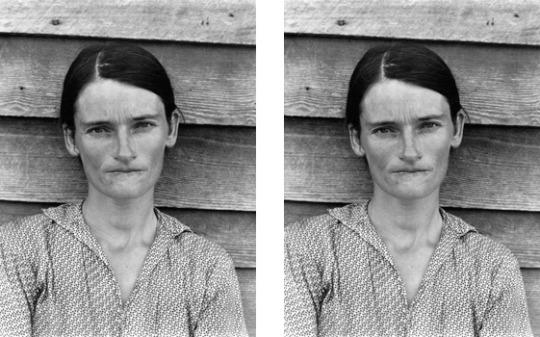
Sherrie Levine, Untitled (After Walker Evans, ca. 1925)
0 notes
Text
March 14/18: Richard Serra’s “Tilted Arc” and the Controversy.
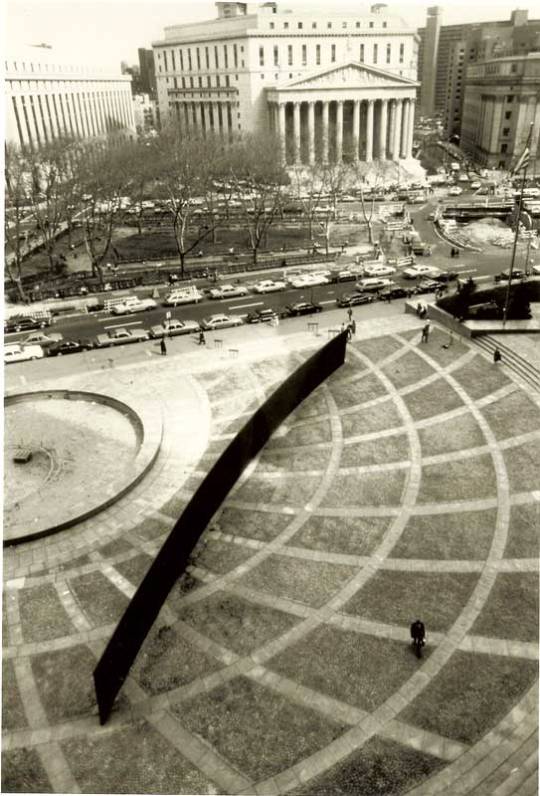
The public art piece titled “Tilted Arc” (1981) is a public art sculpture created by Richard Serra for the Federal Plaza in New York City. It was commissioned by the GSA for an “art-in architecture” program they had.
Serra’s idea for this artwork was he wanted to people to feel like the largeness and scale of the work would engulf them and break up their movement in space. It caused people who walked around the space to consider that society has constructed specific walkways and paths to navigate around space. I feel that in a way it is very similar to how parkour can be considered political for the person doing parkour is deciding how they navigate themselves around the city. According to Khan Academy “Serra saw public art as a way to expose and critique the surrounding public space, not to beautify it” (p 5.)
The piece received a lot of negative criticism and people who works in the building attempted to petition it’s removal. The piece was site specific and created for the Federal Plaza and it would be ruined anywhere else. The decision to remove it went to court and the jury decided that it would get removed. It was taken apart in pieces in 1989 and put into storage.
I actually really like this work before I read about the controversy of the piece, I immediately felt I could articulate what Serra was trying to convey. It is very much a commentary on how much the government controls space and it is also reinforced on how it was removed. Therefore the controversy behind this work actually says more about the works original concept, than it did on its own prior.
Citation: "Richard Serra, Tilted Arc". Khan Academy, 2018,
0 notes
Text
March 3/18: Why do People Still Believe the “Tortured Artist” Trope?
Yesterday in class we were discussing the death of Ana Mendieta and the speculation of her death being suicide or murder. We then began to talk about how people believe that all art needs to come from a dark place but also that artists are all depressed. I personally find this notion of the “tortured artist” be very much created due to the way art historians and critics write romantically about such artists. Such as Pollock as an alcoholic, Van Gogh, Woodman, Bourgeois, Rothko etc.. the list goes on and on. Perhaps for some artists a lot of work does come from pain but to quote Lyotard “art must be pain and pleasure.” I guess I just don’t find it to be healthy of the art market to fetishize on this darkness that an artist must have to produce great work. How many more artists have to kill themselves for us to realize this isn't necessary for many believe post-humous recognition is the way unfortunately. Life is not a romantic retrospective.
Back to Mendieta I was looking at her other work and saw in 2014 there was a retrospective happening of her husband Carl Andre in New York at the Dia Art Foundation. Artist protesters spilled guts in front of the door of the museum to commemorate Mendieta.
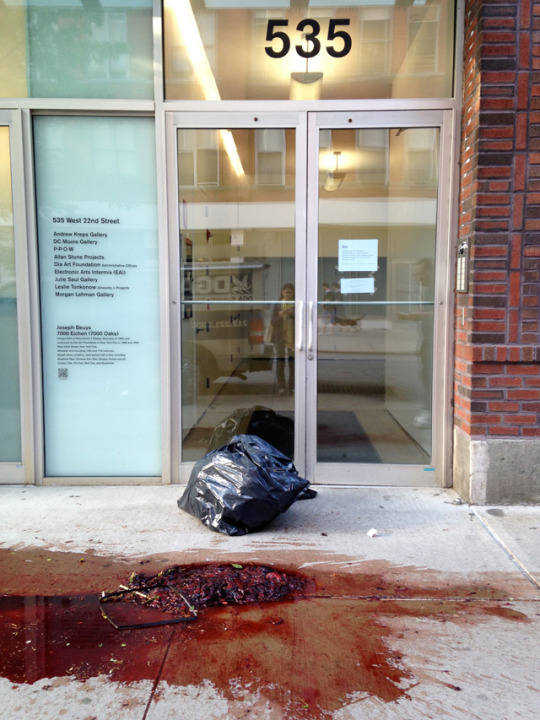
0 notes
Text
Feb 17/18: Less is More: High Modernism, Minimalism, and Aesthetic Interpretation.

“Untitled” (to Tracy, to celebrate the love of a lifetime) (1992) by Dan Flavin
Question: Discuss Dan Flavin’s Untitled (to Tracy to celebrate the love of a lifetime) (1992). How does it negotiate Greenbergian modernism? How do other artists experimenting with light engage with Greenberg’s theories?
Clement Greenberg states that painting should be about painting. “The conceptual cornerstone of modernism, as Greenberg theorized it, was “medium specificity”: the self-reflexive investigation of the constraints of a specific medium through the ongoing practice of the discipline in question” (Costello p2.) Greenberg felt that modernist sculpture could be analyzed in the same way that modernist painting could be. As artists progressed in their work that concept became more and more dated and through that minimalism began. The artist Dan Flavin wanted to push further than Greenberg’s idea of medium specificity, he wanted his materials to be innovative and be able to be changeable and able to change the space around them. His work functions as a sculpture whether it is lit or unlit (Arnason p509.) Another argument of Greenberg’s theories was that it was more about the work and less about the space. While is Flavin’s work the illumination or lack of it, how it changes the space becomes the art. Minimalism does not only work to affect the eyes but also the body of the viewer, with Flavin’s use of light how it reflects off the viewer continuously changes the space.
Citation: Arnason, H H, and Elizabeth Mansfield. History of Modern Art: Painting, Sculpture, Architecture, Photography. Upper Saddle River, NJ: Pearson Prentice Hall, 2010. Print.
MLACostello, Diarmuid. "Greenberg's Kant and the fate of aesthetics in contemporary art theory." The Journal of aesthetics and art criticism 65.2 (2007): 217-228.
0 notes
Text
February 11/17: The Death of Andy Warhol, Valeria Solanas and S.C.U.M. Manifesto.
I am very much into astrology, I have read extensively into creating birth charts and reading about specific planetary placements. What aspect of astrology that really intrigues me the most is Medical Astrology, in which planetary alignments, zodiac house placements can affect peoples illnesses, death, best remedies as well as discovering weak points within a person’s body. While I was conducting a reading on my personal chart about my health I looked to see that I have my 8th house in Pisces, I skimmed the internet to see what famous people also had this astrological placement. I wanted to give myself an idea on what kind of deaths or illnesses occurred within them. Andy Warhol popped up with the same placement as me, he passed in his sleep with a post operative irregular heartbeat.
But what shocked me was to learn about his attack on June 3, 1968 that brought him health troubles that later in life assisted in his death. In 1968 Valeria Solanas was a radical feminist who was an actress in a couple of Warhol’s films. She was a writer and was apparently thrusting scripts at him that he was rejecting. She formed the “Society for Cutting Up Men” or abbreviated to “S.C.U.M.” She self published the S.C.U.M Manifesto in 1967 with intentions of eliminating all men. Here are some quotes from her Manifesto; “The male is a biological accident: the Y (male) gene is an incomplete X (female) gene, that is, it has an incomplete set of chromosomes. In other words, the male is an incomplete female, a walking abortion, aborted at the gene stage. To be male is to be deficient, emotionally limited; maleness is a deficiency disease and males are emotional cripples” (S.C.U.M. par2.) Relating to art, although this entire manifesto is one of the most schizophrenic reads to date Solanas does make a valid point within her frustration as to why women at the time were institutionally unable to be recognized as a “great” artist. “The male `artistic' aim being, not to communicate (having nothing inside him he has nothing to say), but to disguise his animalism, he resorts to symbolism and obscurity (`deep' stuff). The vast majority of people, particularly the `educated' ones, lacking faith in their own judgment, humble, respectful of authority (`Daddy knows best'), are easily conned into believing that obscurity, evasiveness, incomprehensibility, indirectness, ambiguity and boredom are marks of depth and brilliance. `Great Art' proves that men are superior to women, that men are women, being labeled `Great Art', almost all of which, as the anti-feminists are fond of reminding us, was created by men. We know that `Great Art' is great because male authorities have told us so, and we can't claim otherwise, as only those with exquisite sensitivities far superior to ours can perceive and appreciated the slop they appreciated” (S.C.U.M p9.) This is a very mentally ill and overblown reaction to how women in art are rejected, but it is difficult to not sympathize with Solanas’s character for when she turned herself in she proclaimed “He’s controlling my life!” Warhol was the tastemaker in New York art during that time. Unfortunately he reduced the female form and identity to nothing more than a static presence and as a tool for voyeurism. Andy Warhol is a “great” artist, extremely influencial and prolific but he did not contribute to feminism in art what so ever.

Photograph of Valeria Solanas
Citation : “New York: Felled by Scum.” Time, Time Inc., 14 June 1968, content.time.com/time/subscriber/article/0,33009,900118,00.html.
Solanas, Valerie. “SCUM manifesto”. Verso, 1971. New York
“Andy Warhol and Valerie Solanas: Why She Shot Him.” Time, Time, time.com/3901488/andy-warhol-valerie-solanas/.
0 notes
Text
January 27/18: Old Influences New Minus the Sexism.
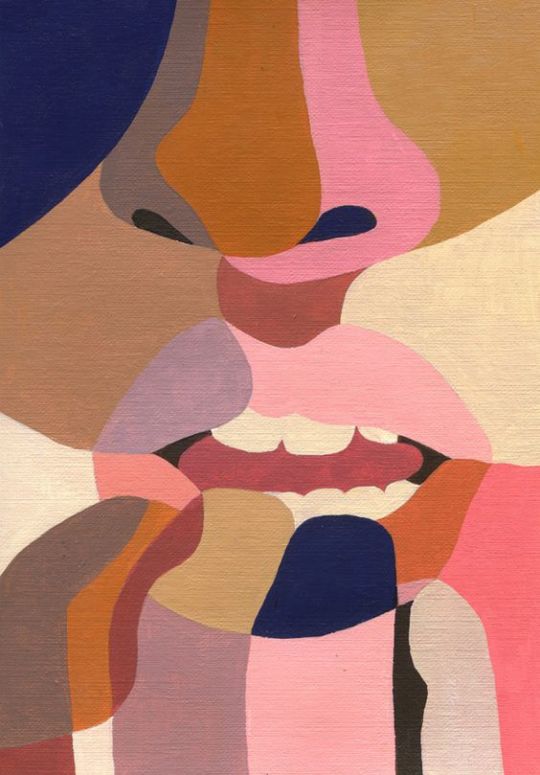
“Kiss” by Ines Longevial (2016)
During class yesterday we were talking about Pop Art and also the other contemporary work that was being around that period. The work that caught my eye was “Great American Nude #57″ by Tom Wesselman (1964.) My immediate response to the work was great *sigh* another female nude with her identity stripped away, nothing more than openings and genitals. The composition is very interesting with extremely flat application of paint, and nice saturation of tones. The genitals are not exposed in this work besides just bare breasts, the open mouth resembles the centre of the daffodil which is next to the figure. The symbol of an open flower has always historically represented fertile or vaginal imagery. Whats so annoying about work like this to study in 2018 is just how dated it really is, what is it really about the subject matter that is interesting in this work? During a specific period in art where radical shifts of what art means and what conceptual or contemporary work is, this particular piece is dated, flat and has no need to be celebrated like it has been.
An artist that I feel should be celebrated though, who is modern and has a similar application of paint is Ines Longevial. Longevial is a french painter, born in 1990. Her work is very similar to Wesselmann in subjects and composition but instead of the voyeuristic male gaze regarding his figures who become objects; Longevial’s work has a tenderness, romance and sense of identity to her figures who are the subject of the work. Wesselmann’s paintings of mouths and lips were meant to be erotic. While Longevial’s depictions of such show a full face in an expression of some sorts destined to convey an emotion of the face that holds it. In her reclining images the woman have faces and are clothed often surrounded by other women in leisure. I wanted to make this post for anyone who enjoys Wesselmann’s work and strip it down to what it is and then reintroduce the same style but in a contemporary and not sexist way.

“Great American Nude #57″ by Tom Wesselmann (1964)
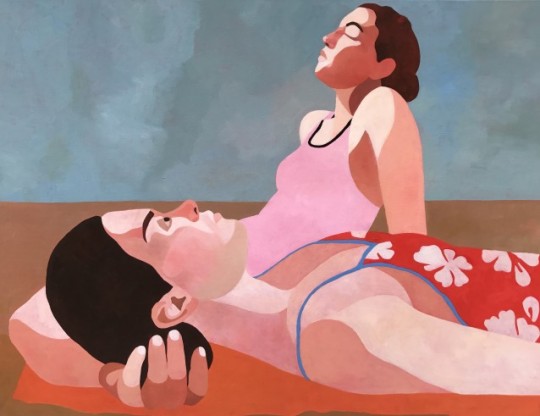
“Sunbath 1″ (2017) by Ines Longevial
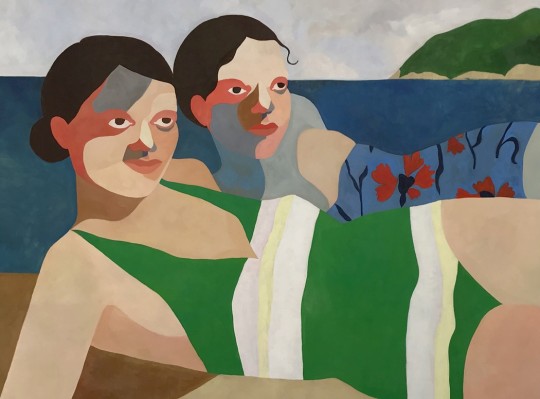
“ Sisters on the Beach” by Ines Longevial (2017)
0 notes
Text
(January 18/18) Abstract Expressionism: New York Steals the Idea of Modern Art
Why might an artist choose abstraction versus representation?
After and during WWll many european artists left Europe to escape the cultural destruction of war. After the war was over artists felt it was their moral duty to adjust their art practices. In H.H Arnason’s History of Modern Art, Barnett Newman states “...felt the moral crisis of a world in shambles, a world devastated by a great depression and a fierce world war, and it was impossible at that time to paint the kind of paintings that we were doing---flowers, reclining nudes, people playing the cello... This was our moral crisis in relation of what to paint (Newman p377.) Abstraction was the direction artists took because it was an evolution moving forward trying to distance oneself from the past.
Citation: Arnason, H. H., 1909-1986. History Of Modern Art : Painting, Sculpture, Architecture, Photography. New York :Harry N. Abrams, Inc., 1998. Print.
For my second part of this post I wanted to draw attention to two female artists of Abstract Expressionism. During my research I often see the female artists of this period regarded at the end of the extensive list of the macho men of Abstract Expressionism. Unfortunately a lot of women artists seem to undergo the same fate in the arts community. Especially the first artist I want to talk about Lee Krasner who’s partner was Jackson Pollock.
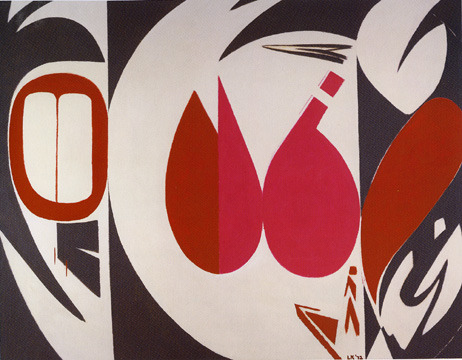
“Mysteries” (1972) by Lee Krasner
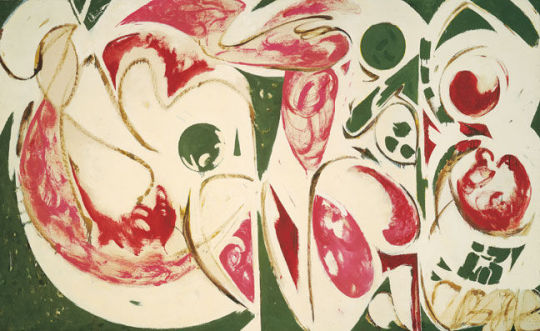
“The Sun Woman II” (1958) by Lee Krasner
Lee Krasner was born in Brooklyn, New York on October 27, 1908. She had several years of classical training and studied to become an art teacher. She recieved full employment through the WPA and was able to practice as an artist full time. After her partner passed Lee Krasner cut up old canvas’s her and her husband had discarded and reinvented them into large scale collage works which have influenced future feminist collage artists. She was a major contributor to Abstract Expressionism and as a Woman artist a tremendous inspiration.
The second artist I want to talk about is considered a “second-generation” abstract expressionist; Grace Hartigan. Grace Hartigan was born on March 28, 1922 in New Jersey and moved to New York in 1945. “In 1952 she spent a year making studies based on Old Master paintings, resulting in a temporary rift from many of her Abstract Expressionist friends, such as Joan Mitchell, and the loss of support from critic Clement Greenberg” (Guggenheim par 2.) Clement Greenberg featured Hartigan in the 1950 exhibition “New Talent” at the Kootz Gallery. In an interview Jonathon Van Dyke in 2001, Hartigan states about her formal decisions and philosophy of her work: “I juggle formal concepts – be it all-over painting, or whether one image is surfacing over another – and I balance these with issues of identity. I ask of the painting, “Are you going to be a paper doll, or a real woman? Are you the actor or the man? Are you the mask or the face?.” I thought that these questions were very interesting to ask yourself as you begin composing a painting and the formal decisions that go into that. Two paintings I want to feature by Hartigan I feel follow the narrative of identity that she mentions in the interview are titled “Marilyn”(1962) and “Trick or Treat” (1965)
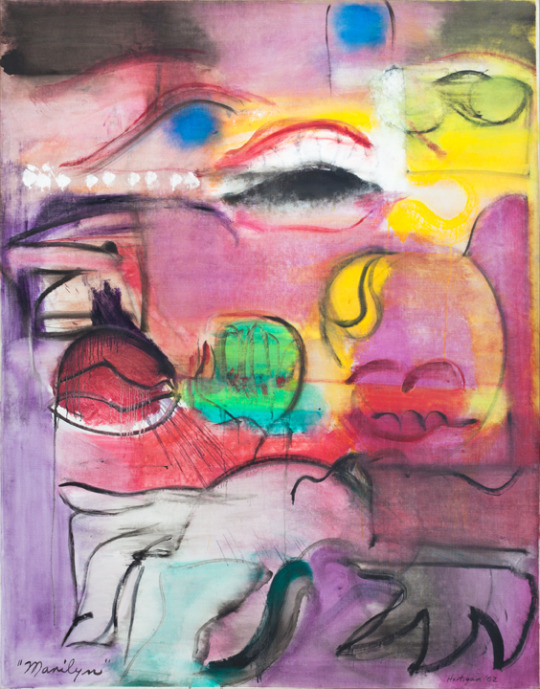
“Marilyn” (1962) by Grace Hartigan
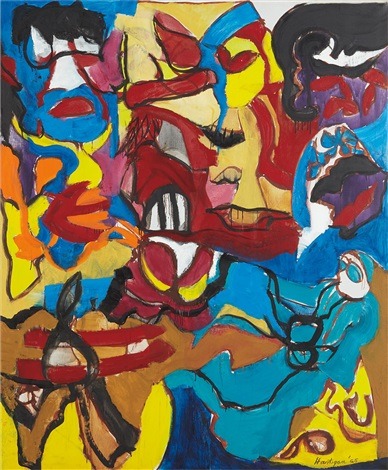
“Trick or Treat” (1965), Oil on Canvas by Grace Hartigan
Citation: “Grace Hartigan.” Guggenheim, THE SOLOMON R. GUGGENHEIM FOUNDATION, www.guggenheim.org/artwork/artist/grace-hartigan.
0 notes
Text
January 6/17: Is the art market irrational? An Introduction to Contemporary Art
Question 1: Would you ever buy a Louis Vuitton handbag designed by Koons or Murakami?
Yes I would. Maybe not from those artists but I know that Yayoi Kusama did a line with Louis Vuitton during her 100 piece series exhibition that was touring in 2012. I personally adored those particular handbags. There is a very neat crossover between fashion and art, commercializing contemporary art seems to be part of the culture of the people who attend the large upscale events. Often to be apart of the art world as a patron one must first have a certain amount of privilege such as financially being comfortable enough to partake in leisure to attend events and exhibitions. To me fashion is wearing art to an extent, the physical garment which is crafted is art in itself. The persona or idea the piece represents to the wearer or the admirer is subjective though and often clothing is a presentation of ones surface level identity. Clothing is a great to express the persona one wants others to see, it makes sense for wealthy art patrons to want to wear garments that are designed by artists. In a way its collecting a piece of art but also projecting an identity attributed to it.
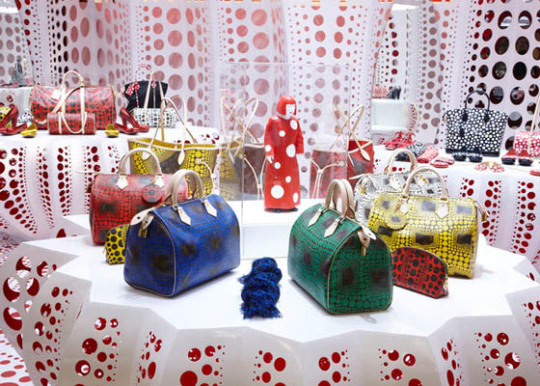
Question 2: What do you think of Koon’s “String of Puppies” (1988)?
I think it is an interesting piece and far more original and easier to swallow than what Richard Prince has been doing with the instagram posts. This sculpture is a reproduction of a photograph by Art Rogers but so much is changed and so much more dimension is added with the oversaturated colours and decorations such as the collars on the blue dogs and the daisy’s in the figures hair. This sculpture reminds me a lot of Yinka Shonibare’s “The Swing” (2001). It is taking a piece of art, reworking its idea into something contemporary and completely original. I feel that in the past 5 years all work that is coming out is a reinvention of a previous idea to curate an image that represents such. I find Koon’s sculpture to be very contemporary and if it was made today would definitely be well recieved.
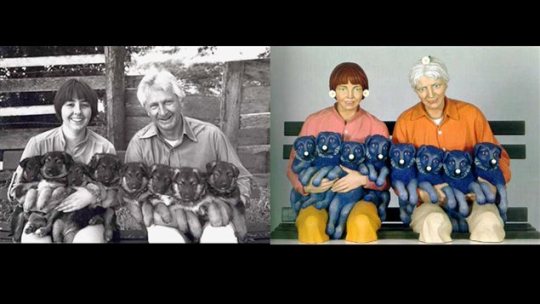
1 note
·
View note